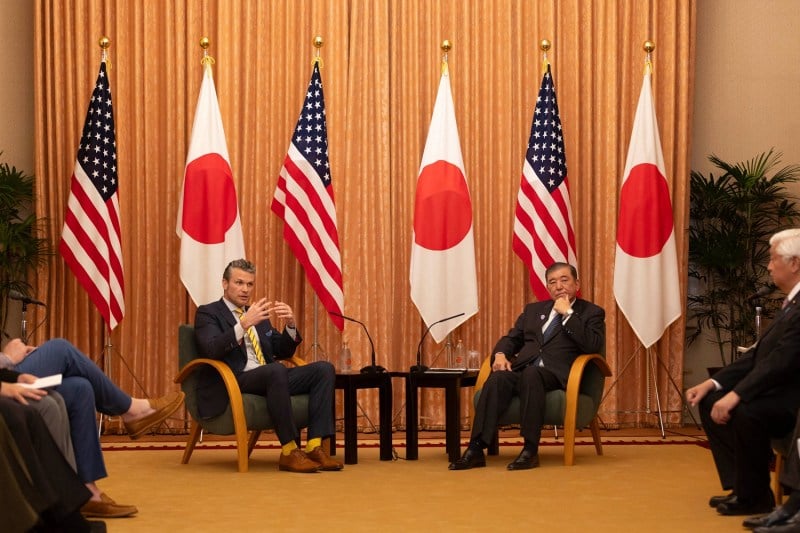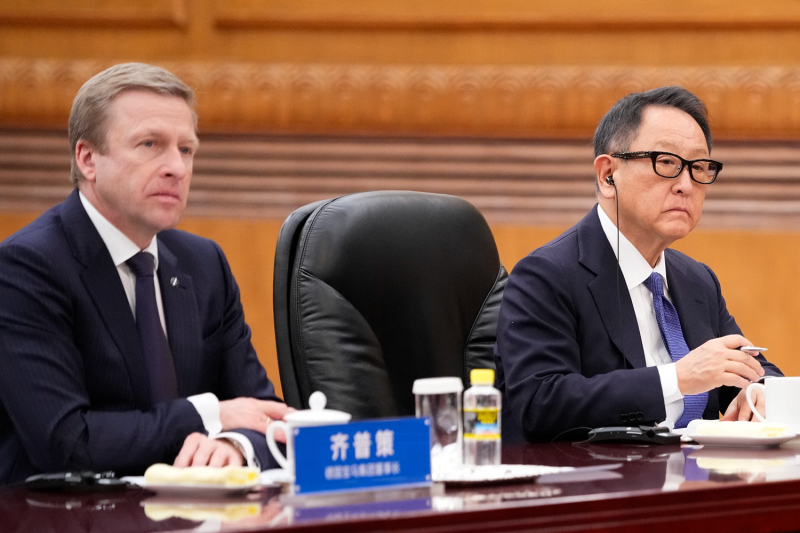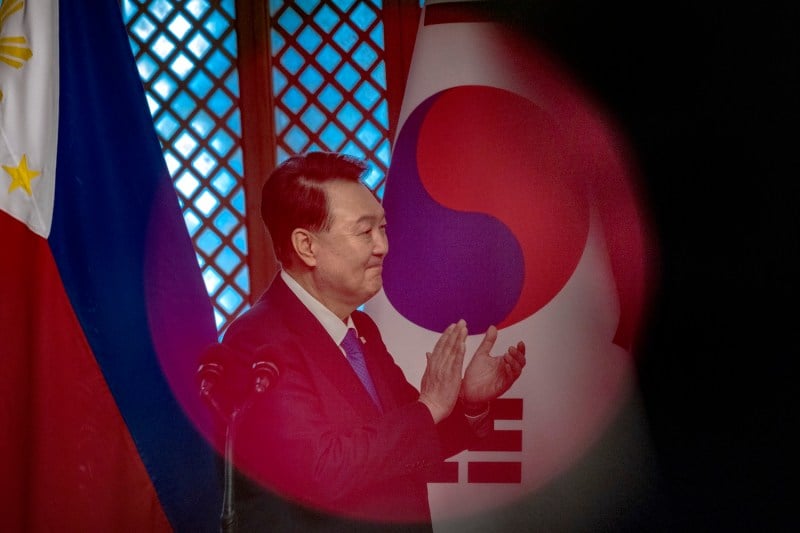Japan Can’t Trust That Things Are Normal With Washington

Japan Can’t Trust That Things Are Normal With Washington
An erratic president means even long-term allies are on thin ice.
U.S. Secretary of Defense Pete Hegseth, left, and Japanese Prime Minister Shigeru Ishiba hold a meeting at the prime minister’s office in Tokyo on March 30. Stanislav Kogiku/POOL/AFP via Getty Images
Pete Hegseth stopped in Japan over the weekend, and it was all strangely normal.
In his remarks at a joint memorial service on Iwo Jima on Saturday and following a meeting with Gen Nakatani, his Japanese counterpart, on Sunday, the U.S. secretary of defense emphasized the importance of the U.S.-Japan alliance for securing a “free and open Indo-Pacific”; called Japan an “indispensable partner in deterring communist Chinese military aggression”; and expressed a commitment to the process of upgrading U.S. Forces Japan to enable closer coordination with the Japan Self-Defense Forces.
Pete Hegseth stopped in Japan over the weekend, and it was all strangely normal.
In his remarks at a joint memorial service on Iwo Jima on Saturday and following a meeting with Gen Nakatani, his Japanese counterpart, on Sunday, the U.S. secretary of defense emphasized the importance of the U.S.-Japan alliance for securing a “free and open Indo-Pacific”; called Japan an “indispensable partner in deterring communist Chinese military aggression”; and expressed a commitment to the process of upgrading U.S. Forces Japan to enable closer coordination with the Japan Self-Defense Forces.
There were no threats to abandon Japan if it does not increase its defense budget or host-nation support. The rhetorical tropes—including references to “lethality” and “war-fighting”—had a harder edge than usual in a U.S.-Japan context but were largely in keeping with the status quo.
At a basic level, this visit, following a meeting (including a Quad foreign ministers meeting) with Secretary of State Marco Rubio on his first day in office and a summit between U.S. President Donald Trump and Japanese Prime Minister Shigeru Ishiba in early February, should reassure Tokyo that U.S. security alliances in Asia are still operative.
But perhaps it shouldn’t.
For Tokyo, the problem is threefold. Despite these rhetorical commitments from the Trump administration, the Japanese government is struggling with the fears of abandonment that haunt every alliance relationship. Even under the Biden administration, changes in the regional security environment—particularly China’s and North Korea’s increasingly sophisticated nuclear arsenals—led Tokyo to press for greater reassurance on extended deterrence.
Charles de Gaulle’s question from the Cold War—is the United States really prepared to trade New York for Paris?—is as salient as ever, especially under Trump. The U.S. president’s abandonment of Ukraine and his widening rift with Europe have only deepened fears in Tokyo. It is difficult for Tokyo to watch Germany commit to an unprecedented defense buildup or French President Emmanuel Macron float the idea of a French nuclear umbrella for Europe and not wonder whether it needs to consider similar steps, even if Trump and his officials have said the right things in bilateral meetings.
Beyond ordinary fears of abandonment, Tokyo faces the larger challenge of determining the Trump administration’s broader strategy. Perhaps the contrast between its approach to Europe and its approach to Asian allies simply means that Trump is doing his own version of a “pivot to Asia.”
But not every faction in the Trump administration is necessarily committed to Asia First—and it is unclear what Trump’s own intentions are for diplomacy with North Korea’s Kim Jong Un or, for that matter, China’s Xi Jinping. How Trump handles his authoritarian counterparts will be at least as revealing about the Trump administration’s approach to Asia as rhetoric from the president or other senior officials.
Meanwhile, to the extent that the Trump administration is prioritizing “strategic competition” with China, it is a more cramped approach to competition than its predecessor. It was less than a year ago that Fumio Kishida, Ishiba’s predecessor, spoke to a joint session of the U.S. Congress about the global partnership between Japan and the United States that was working in concert to preserve an international order that, in Kishida’s words, “championed freedom and democracy” and “encouraged the stability and prosperity of nations.” The Trump administration’s attack on international aid, democracy promotion, scientific research, and the safety of foreign students has broken any sense that the U.S. shares these commitments.
Even if it feels secure that the Trump administration is committed to defending Japan, it could find itself allied to a United States whose behavior is increasingly not just at odds with but actively hostile to Japan’s own national interests and beliefs. Kishida was fond of talking about a “free and open international order based on the rule of law.” For the Japanese government, this was not just a rhetorical flourish.
As articulated in Japan’s 2022 national security strategy, “[ensuring] an international environment that is conducive to facilitating cross-border economic and social activities such as trade of goods, energy, and food which are essential for industries, and the movement of people” is a fundamental national interest. Meanwhile, as a smaller power neighboring Russia and China, it immediately understood that Russia’s invasion of Ukraine was a threat to Japan’s own security in that it represented a fundamental break with a world order based on the rejection of territorial conquest.
Now, Tokyo faces a U.S. that is not only hinting at rewarding Russia’s aggression but also threatening its own neighbors and allies, withdrawing from international organizations that provide crucial global public goods, and erecting new trade barriers with reckless abandon.
To be sure, Japan has already had to live with a certain amount of dissonance with the United States, at least since Trump withdrew from the Trans-Pacific Partnership—a multilateral deal that was intended both to promote trade and counter Chinese influence—with the support of many Democrats.
Tokyo has already recognized that the U.S. policy in Asia would prioritize its military power first, leaving Japan to look to other partners—including China—when it comes to safeguarding the regional economic integration that has enabled it to prosper. But if the Trump administration is pursuing a military-power-only approach to Asia while not only withdrawing from regional economic cooperation but actively disrupting a rules-based trading system, the dissonance will become more extreme.
In psychology, cognitive dissonance is resolved by changing one’s beliefs or changing one’s actions. In time, the Trump administration’s break with the postwar international order could present Japan with a similar choice. Tokyo may eventually have to decide if it is prepared to accept an “America First” world—even at the expense of international institutions, rules, and norms that it says are indispensable to its national interests—or decide that the price of the security relationship with the United States is too steep and that, like Europe, it needs to make significantly greater investments in its own security and draw closer to other countries interested in preserving a rules-based order.
While bilateral meetings like the defense ministerial meeting with Hegseth may lead some in Tokyo to believe that it can put off a reckoning with the dissonance inherent in an alliance with a United States hostile to a rules-based global order, Japan should be under no illusions. As Canadians and Europeans have learned, change can be abrupt.
Tobias Harris is founder and principal of Japan Foresight, a political risk consultancy and the author of The Iconoclast: Shinzo Abe and the New Japan. X: @observingjapan
More from Foreign Policy
-

An illustration shows a golden Cybertruck blasting through a U.S. seal of an eagle holding arrows and laurel. Is America a Kleptocracy?
Here’s how life could change for the rich, poor, and everyone in between.
-

The flag of the United States in New York City on Sept. 18, 2019. America Is Listing in a Gathering Storm
Alarms are clanging at the U.S. geographic military commands around the globe.
-

U.S. President Donald Trump shakes hands with Supreme Court Chief Justice John Roberts during Trump’s inauguration in Washington, D.C. The U.S. Judicial Crisis Is Uniquely Dangerous
But other democracies provide a roadmap for courts to prevail over attacks from the executive branch.
-

An illustration shows a golden Newtons cradle with Elon Musk depicted on the one at left and sending a globe-motif ball swinging at right. Elon Musk’s First Principles
The world’s richest man wants to apply the rules of physics to politics. What could go wrong?








Join the Conversation
Commenting on this and other recent articles is just one benefit of a Foreign Policy subscription.
Already a subscriber?
.
Subscribe
Subscribe
View Comments
Join the Conversation
Join the conversation on this and other recent Foreign Policy articles when you subscribe now.
Subscribe
Subscribe
Not your account?
View Comments
Join the Conversation
Please follow our comment guidelines, stay on topic, and be civil, courteous, and respectful of others’ beliefs.
Change your username |
Log out
Change your username:
CANCEL
Confirm your username to get started.
The default username below has been generated using the first name and last initial on your FP subscriber account. Usernames may be updated at any time and must not contain inappropriate or offensive language.